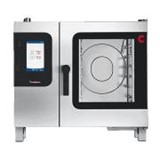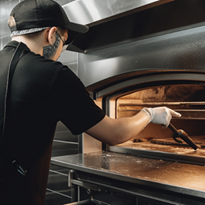Achieving the Perfect Crust: Temperature and Cooking Time
When it comes to making the perfect pizza, achieving the perfect crust is crucial. The crust is the foundation of any good pizza, and getting it just right can make all the difference. One of the key factors in achieving a perfect crust is the temperature and cooking time.
Preheating the Oven
To start off, it's essential to preheat your oven properly. Whether you're using a traditional deck oven or a modern conveyor oven, giving it enough time to reach the desired temperature is vital. Preheating ensures that the pizza cooks evenly and that the crust develops a beautiful golden color.
Finding the Ideal Temperature
The ideal temperature for baking pizza varies depending on the type of oven you're using and the pizza style you want to achieve. For a Neapolitan-style pizza with a soft and chewy crust, a temperature of around 800°F (425°C) is recommended. On the other hand, a New York-style pizza with a slightly crispier crust can be baked at a lower temperature of 550°F (290°C).
Determining the Cooking Time
Cooking time also plays a significant role in achieving the perfect crust. It's essential to strike the right balance between cooking the toppings and getting the crust to the desired level of crispiness. Generally, a pizza takes around 8 to 12 minutes to cook at the recommended temperatures, but this can vary depending on the thickness of the dough and the toppings used.
Experimenting with Alternative Cooking Methods
Aside from traditional deck and conveyor ovens, other cooking methods can also produce outstanding pizza crusts. For example, a brick oven or a wood-fired oven can impart a unique smoky flavor and a crispy texture to the crust. Similarly, using a pizza stone in a conventional home oven can mimic the effects of a brick oven and yield excellent results.
Using Different Heat Zones for Various Pizza Styles
Professional pizza chefs often use different heat zones within their pizza ovens to achieve different pizza styles. This technique allows them to create a variety of pizzas in a single oven without compromising on quality.
Utilizing the Hot Spot
In a deck oven, there's often a "hot spot" where the heat is more concentrated. This area is perfect for creating Neapolitan-style pizzas that require a high temperature for a short cooking time. Placing the pizza in this hot spot results in a charred crust with a soft and chewy interior.
Utilizing the Cooler Zone
On the other hand, if you're making a New York-style or a thicker crust pizza, placing it in a slightly cooler zone within the oven ensures that the crust cooks through evenly without burning the toppings.
The Rotating Deck Advantage
Some advanced deck ovens come equipped with rotating decks, which provide even heat distribution and consistent baking. This feature is particularly useful for high-volume pizzerias that require quick and reliable results.
Fine-Tuning Heat Zones for Unique Combinations
One of the joys of pizza-making is experimenting with various toppings and ingredient combinations. As a skilled pizza chef, you can fine-tune your heat zones to accommodate the cooking needs of unique pizzas, whether they have delicate ingredients that require gentle cooking or bold flavors that benefit from intense heat.
Handling Multiple Pizza Orders Efficiently
In a busy pizzeria or restaurant, handling multiple pizza orders efficiently is vital to keep customers satisfied and maintain a steady workflow. Here are some tips to manage multiple pizza orders like a pro:
Organize Your Workspace
Keeping your workspace organized is crucial for efficiency. Arrange all the necessary ingredients and tools in a way that minimizes movement and allows you to reach everything you need quickly.
Prep and Pre-portion Ingredients
Prepping and pre-portioning the ingredients before the rush can save valuable time. Have all the toppings, sauces, and cheeses ready to go, so when an order comes in, you can assemble the pizza without delay.
Use Timers
Using timers for each pizza can help you keep track of cooking times, especially when you have multiple pies in the oven at once. This ensures that each pizza is cooked to perfection and prevents any overcooking.
Streamlining Order Taking
Having an efficient order-taking system in place is essential for managing multiple pizza orders. Consider using digital tools or POS systems to process orders quickly and accurately, reducing the chances of errors and delays.
Teamwork and Communication
A well-coordinated team is the backbone of a successful pizzeria. Effective communication between the kitchen staff, servers, and managers ensures smooth operations during peak hours.
Tips for Proper Dough Preparation and Stretching
The dough is the heart of any pizza, and how it's prepared and stretched can significantly impact the final result. Here are some tips for proper dough preparation and stretching:
Quality Ingredients
Start with high-quality flour, yeast, and water. The type of flour and the hydration level will influence the texture and flavor of the crust. Experiment with different flour blends to find the one that suits your desired pizza style.
The Right Kneading Technique
Properly kneading the dough is essential for developing the gluten, which gives the dough its elasticity. Knead the dough until it becomes smooth and stretchy, but be careful not to over-knead it, as it can result in a tough crust.
Give It Time to Rest
After kneading, let the dough rest to allow the gluten to relax. This makes the dough easier to stretch without snapping back. Resting times can vary depending on the recipe, but around 1 to 2 hours is typically sufficient.
Stretching Techniques
There are several stretching techniques, such as hand tossing, using a rolling pin, or stretching it over your knuckles. Find the method that works best for you and practice to achieve consistently sized and shaped pizza crusts.
Acrobatic Dough Tossing
Hand-tossing pizza dough not only adds a touch of theatrics but also helps distribute the weight evenly, resulting in a more even and balanced crust. While it may take some practice, mastering the art of dough tossing can elevate your pizza-making skills to new heights.
Choosing the Right Pizza Paddles and Tools
Having the right pizza paddles and tools is essential for smooth pizza preparation and baking. Here are some popular options:
Wooden Pizza Peel
A wooden pizza peel is ideal for transferring pizzas into and out of the oven. The wooden surface reduces the chance of sticking, and its long handle keeps your hands safely away from the heat.
Metal Pizza Peel
A metal pizza peel is useful for turning and adjusting pizzas in the oven. Its thin edge can slide under the pizza with ease, making it handy for quick movements during the baking process.
Dough Docker
A dough docker is a small tool with spiked wheels that are rolled over the dough before adding toppings. It helps prevent excessive rising during baking, resulting in a more even crust.
Pizza Cutter
A good pizza cutter is a must-have for slicing the pizza into perfect portions. Opt for a sharp, high-quality cutter to achieve clean cuts without squashing the toppings.
Experimenting with Specialty Tools
As you become more experienced in pizza-making, you may want to explore specialty tools such as pizza scissors, dough scrapers, or perforated pans for unique and creative pizza presentations.
Utilizing Rotating Decks (for Deck Ovens) or Conveyor Speed (for Conveyor Ovens)
For pizzerias using deck pizza ovens, utilizing rotating decks can significantly improve the baking process. Rotating decks ensure even cooking and a consistent crust on every pizza. This feature is particularly advantageous when dealing with a high volume of pizzas.
For establishments with conveyor ovens, controlling the speed of the conveyor belt is crucial. The conveyor speed determines the cooking time, and adjusting it allows you to customize the doneness of each pizza. It's also essential to maintain the conveyor belt regularly to ensure smooth operation and prevent any disruptions during busy hours.
Embracing Seasonal Ingredients and Specials
To stand out from the competition, consider creating seasonal pizza specials that showcase fresh, locally sourced ingredients. Customers appreciate variety, and offering unique, limited-time pizzas can attract new patrons and keep regulars excited to try something new.
Exploring Gluten-Free and Vegan Options
With an increasing demand for dietary accommodations, offering gluten-free and vegan pizza options can expand your customer base. Experiment with alternative flours and dairy-free cheeses to create delicious alternatives that cater to various dietary preferences.
Building an Online Presence
In today's digital age, having a strong online presence is crucial for attracting customers and increasing visibility. Create a professional website for your pizzeria, complete with high-quality images of your delectable pizzas and an updated menu. Engage with customers on social media platforms to build a loyal following and encourage user-generated content.
Showcasing Pizza-Making Classes and Events
Hosting pizza-making classes and events can be a fun and interactive way to connect with your community. These events not only promote your pizzeria but also establish your establishment as a hub for pizza enthusiasts and food lovers alike.
Engaging with Customer Reviews and Feedback
Online reviews can significantly influence a potential customer's decision to dine at your pizzeria. Respond to both positive and negative reviews professionally and graciously. Taking constructive feedback into account shows your commitment to providing the best possible pizza experience.
In conclusion, optimizing pizza cooking techniques and tips is an ongoing journey of culinary excellence. From mastering the art of achieving the perfect crust to efficiently handling multiple pizza orders, every aspect of pizza-making contributes to its success.
As you embrace experimentation, explore new ingredients, and showcase your passion for pizza, you will undoubtedly leave other pizzerias behind and rise in Google rankings. By consistently delivering high-quality, delicious pizzas and providing exceptional customer experiences, your pizzeria will become a go-to destination for pizza lovers far and wide.
With dedication, creativity, and a touch of Italian flair, your pizzeria will thrive and earn its rightful place among the top pizza establishments in the industry.


















